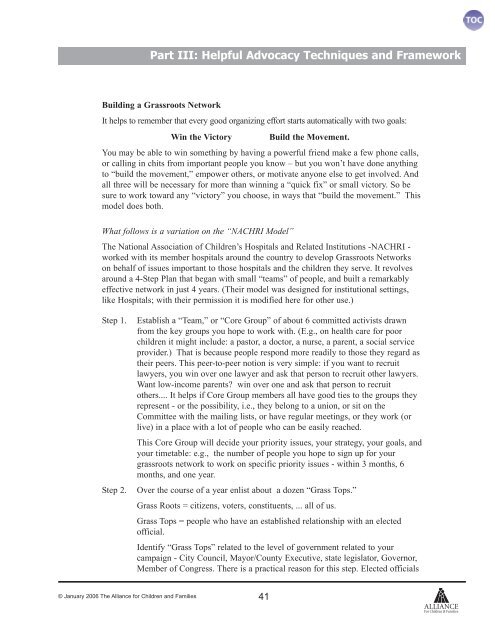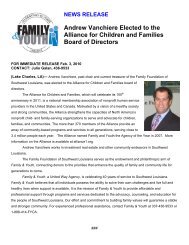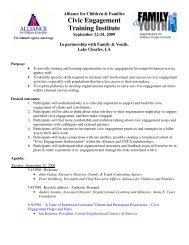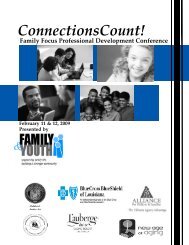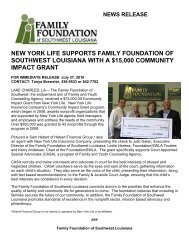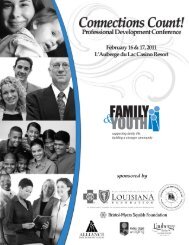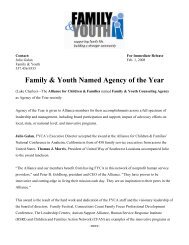Mission-based Advocacy Toolkit from Alliance for Children & Families
Mission-based Advocacy Toolkit from Alliance for Children & Families
Mission-based Advocacy Toolkit from Alliance for Children & Families
Create successful ePaper yourself
Turn your PDF publications into a flip-book with our unique Google optimized e-Paper software.
Part III: Helpful <strong>Advocacy</strong> Techniques and Framework<br />
Building a Grassroots Network<br />
It helps to remember that every good organizing ef<strong>for</strong>t starts automatically with two goals:<br />
Win the Victory Build the Movement.<br />
You may be able to win something by having a powerful friend make a few phone calls,<br />
or calling in chits <strong>from</strong> important people you know – but you won’t have done anything<br />
to “build the movement,” empower others, or motivate anyone else to get involved. And<br />
all three will be necessary <strong>for</strong> more than winning a “quick fix” or small victory. So be<br />
sure to work toward any “victory” you choose, in ways that “build the movement.” This<br />
model does both.<br />
What follows is a variation on the “NACHRI Model”<br />
The National Association of <strong>Children</strong>’s Hospitals and Related Institutions -NACHRI -<br />
worked with its member hospitals around the country to develop Grassroots Networks<br />
on behalf of issues important to those hospitals and the children they serve. It revolves<br />
around a 4-Step Plan that began with small “teams” of people, and built a remarkably<br />
effective network in just 4 years. (Their model was designed <strong>for</strong> institutional settings,<br />
like Hospitals; with their permission it is modified here <strong>for</strong> other use.)<br />
Step 1. Establish a “Team,” or “Core Group” of about 6 committed activists drawn<br />
<strong>from</strong> the key groups you hope to work with. (E.g., on health care <strong>for</strong> poor<br />
children it might include: a pastor, a doctor, a nurse, a parent, a social service<br />
provider.) That is because people respond more readily to those they regard as<br />
their peers. This peer-to-peer notion is very simple: if you want to recruit<br />
lawyers, you win over one lawyer and ask that person to recruit other lawyers.<br />
Want low-income parents? win over one and ask that person to recruit<br />
others.... It helps if Core Group members all have good ties to the groups they<br />
represent - or the possibility, i.e., they belong to a union, or sit on the<br />
Committee with the mailing lists, or have regular meetings, or they work (or<br />
live) in a place with a lot of people who can be easily reached.<br />
This Core Group will decide your priority issues, your strategy, your goals, and<br />
your timetable: e.g., the number of people you hope to sign up <strong>for</strong> your<br />
grassroots network to work on specific priority issues - within 3 months, 6<br />
months, and one year.<br />
Step 2. Over the course of a year enlist about a dozen “Grass Tops.”<br />
Grass Roots = citizens, voters, constituents, ... all of us.<br />
Grass Tops = people who have an established relationship with an elected<br />
official.<br />
Identify “Grass Tops” related to the level of government related to your<br />
campaign - City Council, Mayor/County Executive, state legislator, Governor,<br />
Member of Congress. There is a practical reason <strong>for</strong> this step. Elected officials<br />
© January 2006 The <strong>Alliance</strong> <strong>for</strong> <strong>Children</strong> and <strong>Families</strong> 41


